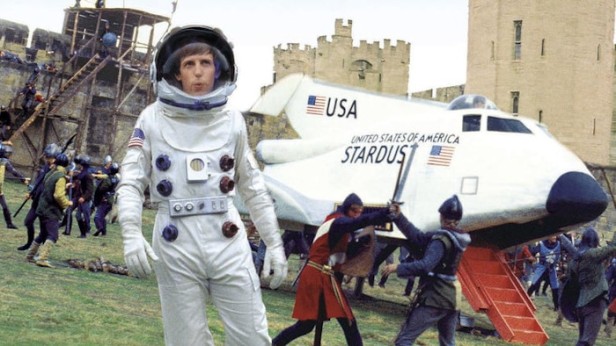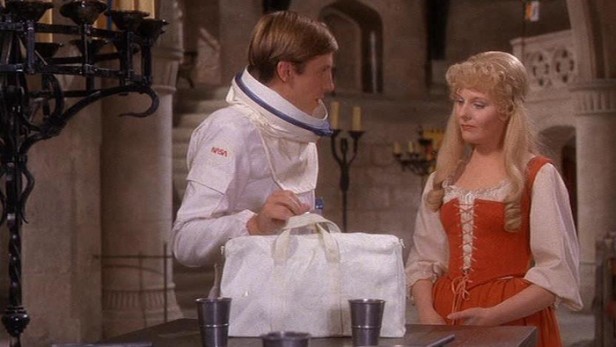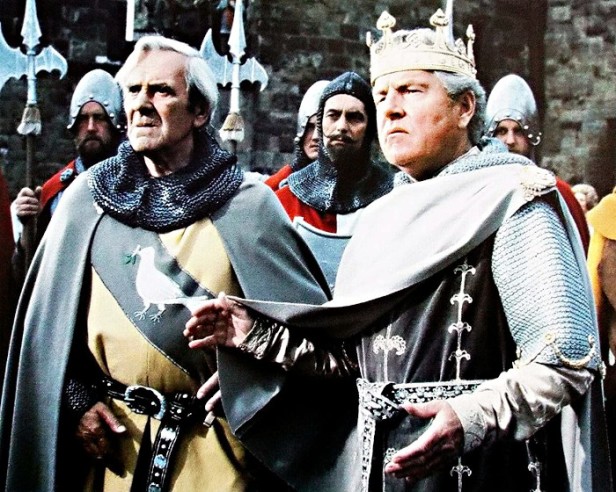Aka: The Spaceman and King Arthur; A Spaceman in King Arthur’s Court
Alongside their more famous and ground-breaking animated feature films, Disney has long had a strand of live-action films that rarely quite captured the public imagination like the animations. Some, notably Treasure Island (1950) and 20,000 Leagues Under the Sea (1954) remain excellent and others that blended live action with animation, like Mary Poppins (1964) and Bedknobs and Broomsticks (1971), enjoyed the best of both worlds. But while the likes of the Witch Mountain films, the interminable adventures of Herbie, the Volkswagen Beetle with a mind of its own and standalones like In Search of the Castaways (1962), The Gnome-Mobile (1967) and Blackbeard’s Ghost (1968) have their followers but are largely forgettable.
There was a particular strain centred around Medfield College (Absent-Minded Professor (1961), Son of Flubber (1963), The Computer Wore Tennis Shoes (1969), Now You See Him, Now You Don’t (1972) and The Strongest Man in the World (1975)) and although Unidentified Flying Oddball doesn’t actually belong to that series it does have the same sort of feel. It’s also part of a string of films that Disney made in response to the success of Star Wars (1977), among them Return from Witch Mountain (1978), The Cat from Outer Space (1978), The Black Hole (1979) and The Watcher in the Woods (1980).

NASA is planning to launch a faster-than-light ship, the Stardust, but politicians are wary of allowing it to manned by human astronauts due to the incredible dangers involved. The Agency gets Tom Trimble (Dennis Duggan) to build a humanoid robot likeness of himself, Hermes, to go on the mission instead but as the launch approaches, Tom finds himself trapped aboard the ship. Launched into space, the Stardust travels through a time warp and arrives back on Earth in Britain in 508 A.D. during the rule of King Arthur. Tom falls in with a local woman, Alisande (Sheila White), who believes that her father has been turned into a goose by the evil Merlin (Ron Moody) and helps Arthur and his knights to defend Camelot from the machinations of the equally wicked Sir Mordred (Jim Dale).
The alternative titles are more explicit in underlining the film’s debt to Mark Twain’s novel A Connecticut Yankee in King Arthur’s Court (1899) and one can only assume that the Unidentified Flying Oddball was settled on to plug into the UFO craze that followed in the wake of Steven Spielberg’s Close Encounters of the Third Kind (1977). Under any title it’s a hit and miss affair, inoffensive but dull, hopelessly predictable but boasting a fine British supporting cast though sadly the script reduces their characters, some of the most famous an revered in names from Britain’s most enduring myth, to little more than comic sidekicks.

Dennis Duggan makes for a bland and unmemorable leading man (to make it worse we get two of him). Duggan went on to become a director, inflicting a number of Adam Sandler films on the world including Happy Gilmore (1966), Big Daddy (1999), I Now Pronounce You Chuck and Larry (2007) and Grown Ups (2010) among many other not-terribly-inspiring comedies. His performance in Unidentified Flying Oddball is underwhelming though he’s not helped one jot by Don Tait’s script which alternates between painting Tom as genius (he builds a fully functioning humanoid robot, single-handed, from scratch) and a blithering idiot (he can’t work out why the residents of 508 A.D. are so terrified of a man stomping around the countryside in a spacesuit).
The British supporting cast are the best reason to watch the film. Sheila White doesn’t quite work as the romantic lead but old hands like Kenneth More (making his final screen appearances), John Le Mesurier and Ron Moody are great value and Jim Dale makes for a nicely villainous Mordred. With Rodney Bewes, Cyril Shaps and Ewen Solon along for the ride (as well as token American Robert Betty and Canadian Bruce Boa) it’s a treat for fans of fine British actors even if most of them are hopelessly miscast and the script doesn’t really give them much to get their teeth into.

Most of the jokes fall rather flat and there are some very questionable moments of taste. Tom’s eye-watering blazer and bow tie combination is a staggering affront to the senses and Unidentified Flying Oddball has the dubious distinction of being the only Disney film in which a copy of that defiantly un-child-friendly publication Playboy plays a small but jolting role.
The budget can’t have been all that much and although director Russ Mayberry (mainly a hard worker on television, his only other big screen outing being biker movie The Jesus Trip in 1971) as able to make use of Alnwick Castle in Northumberland he doesn’t do a lot with it and the climactic battle scene looks noticeably undernourished, the size of Mordred’s army being particularly feeble. The special effects are rather shaky too (literally in the case of the space shuttle scenes) and not even the must undiscriminating of kids – still reeling from the cinematic sugar rush of Star Wars – would have been convinced by the ridiculous jet pack scenes at the end of the film, particularly when the cable holding up Duggan (or his stuntman) keeps hoving into view.

And that was really the film’s greatest problem. It was popular enough at the time but was already looking long in the tooth, a throwback to the kind of slapstick-heavy, child-friendly entertainment that clogged up cinemas during school holidays throughout the 1960s and 70s and post-Star Wars it was lacking in some of the spectacle and excitement that young audiences now demanded. It was regularly reissued (in the UK it did good business on a double bill with Dumbo (1941)) and was certainly popular enough to warrant a sequel in 1995, Michael Gottlieb’s A Kid in King Arthur’s Court which saw the return of Ron Moody’s Merlin, albeit this time as a good guy rather than the pantomime villain of Unidentified Flying Oddball.
The rather stunted-looking Stardust space shuttle lives on as an attraction at the theme park Blackgang Chine on the Isle of Wight where it formed part of the Adventureland display that was closed in 1994 following a landslide. For many years visitors were allowed to go inside the prop but that was stopped when age started to take its toll and the model became more delicate.